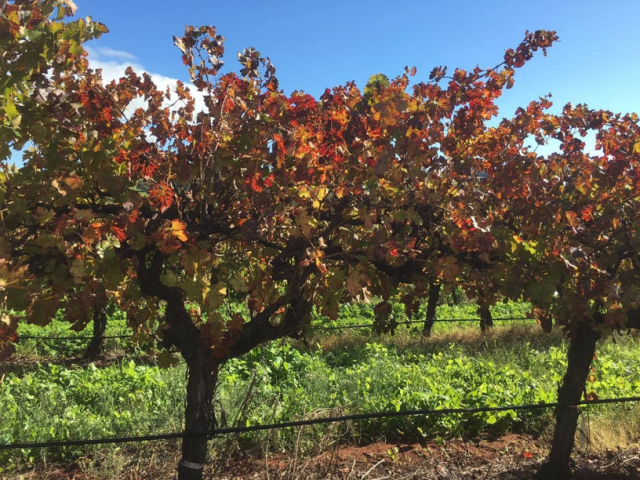The influence of leafroll virus on Houghton clones of Cabernet Sauvignon

Using the Houghton Clones, Western Australia’s own Cabernet Sauvignon grapevine selection, UWA Masters student Haakon Nielssen sought to determine whether the presence of grapevine leafroll associated virus (GLRaV) contributes to the expression of traits beneficial to wine making.
A reverse transcription-polymerase chain reaction (RT-PCR) survey of four highly rated Houghton clones located at two Western Australian vineyards found leafroll virus 5 or 9 in all clones in both vineyards.
A comparison between leafroll infected and uninfected vines of wine making traits found no significant differences.
The comparison of wine making traits suggests that the presence of leafroll virus is not harming grape production. Indeed, the study postulates that leafroll may contribute to expression of beneficial wine making traits in the Houghton clones.
Houghton clones
The original Cabernet Sauvignon vines that became the Houghton clones were introduced to Western Australia between 1836 and 1895, most likely from South Africa.
In the 1930s the Houghton Vineyard took cuttings from old bush vines in Middle Swan to establish a 1.6 hectare planting known as the ‘Houghton Cabernet block’. Although the vigour, yield and wine making qualities varied across the Houghton Cabernet block, legendary Houghton winemaker Jack Mann was firmly of the view that grapes from the block could be used to make outstanding wines.
In the 1960s, a small clonal selection program of Cabernet Sauvignon was established by the Department of Agriculture in partnership with the Houghton Winery.
Through several years of evaluation, a refined group of these 21 ‘Houghton clones’ were selected and planted in “foundation blocks” at Moondah Brook Vineyard in Gingin in 1970 and subsequently at Westfield Vineyard in Frankland River in 1973 using cuttings from Gingin.
These clones were the basis of expansion of the Cabernet Sauvignon plantings into the Great Southern and Margaret River regions in the late 1960s and 1970s.
However, from 1976 to the late 1990s, the Houghton Clones became neglected as imported clones, primarily South Australian selection SA126, became favoured.
In the late 1990s at the request of the Western Australian wine industry, the department re-established research into the viticultural and wine quality traits of several of the Houghton clones. This research focused on the Westfield foundation block in Frankland River.
As a result of favourable comparisons with imported clones in blind sensory tastings, the industry has once again become interested in the Houghton clones for future plantings and re-plantings.
Study results
As predicted, leafroll virus was found in clones 9 and 20 in the Gingin Houghton clone foundation block.
Despite leafroll symptoms being selected out of the Westfield Houghton foundation block, the study found that the leafroll virus still persists in at least a few vines.
Also, although clones 5 and 19 do not express leafroll symptoms, they were found to contain leafroll virus -5 nonetheless.
| Gingin Houghton clone foundation block | Westfield Houghton clone foundation block | |||
| Clone 9 | GLRaV-9 in 4 out of 5 vines tested | Clone 9-7 | GLRaV-9 in 4 out of 5 vines tested | |
| Clone 20 | GLRaV-9 in 4 out of 5 vines tested | Clone 20-4 | GLRaV-5 in 1 out of 5 vines tested
| |
| Clone 5 | GLRaV-5 in 1 out of 5 vines tested | Clone 5-7 | GLRaV-5 in 1 out of 5 vines tested | |
| Clone 19 | GLRaV-5 in 1 out of 5 vines tested | |||
Comparing wine making traits of grapes from leafroll virus infected and uninfected vines found that there were no statistical differences between them.
| Positive for GLRaV 5 and/or 9 | Negative for GLRaV 5 and/or 9 | p | |
| Mean berry weight (g)
| 1.4 | 1.3 | 0.66 |
| Mean Brix° | 20.0 | 19.3 | 0.77 |
| Mean titratable acidity (g/L) | 8.6 | 9.7 | 0.15 |
| Mean total anthocyanins (ug/ml) | 152.6 | 160.4 | 0.37 |
Conclusions
Leafroll virus 5 or 9 can be found in all of the Houghton clones, even clones that were thought to be leafroll virus free due to lack of expression of leafroll disease.
Comparison of wine making traits in leafroll virus positive vines and negative vines found no significant differences.
Given that the clones sampled represent the top wine making Houghton clones, it can be assumed that the presence of leafroll virus does not negatively impact on the vine’s wine making potential and it may be possible that leafroll viruses contribute to them.
For more information email Haakon Nielssen.
